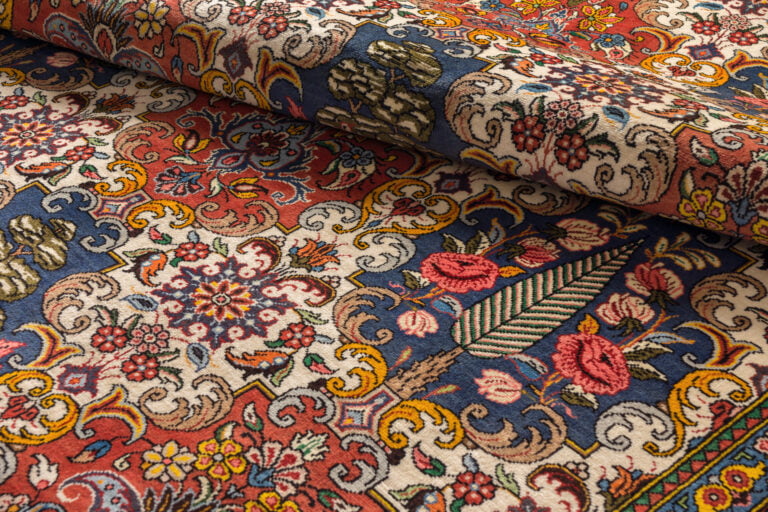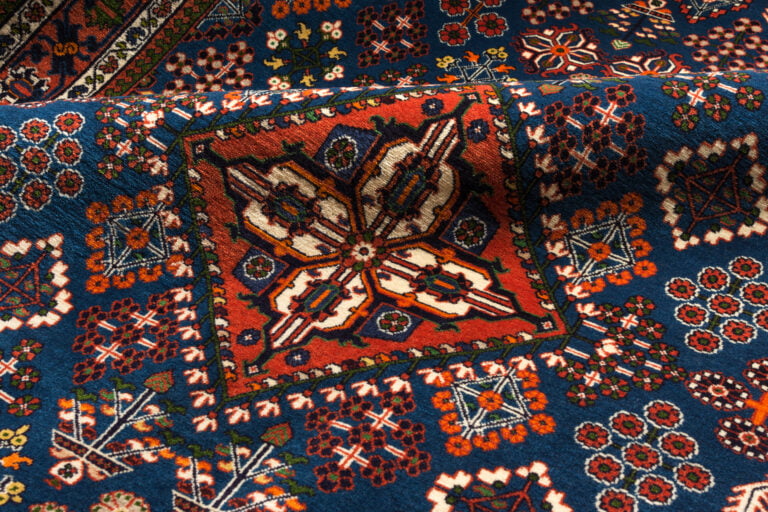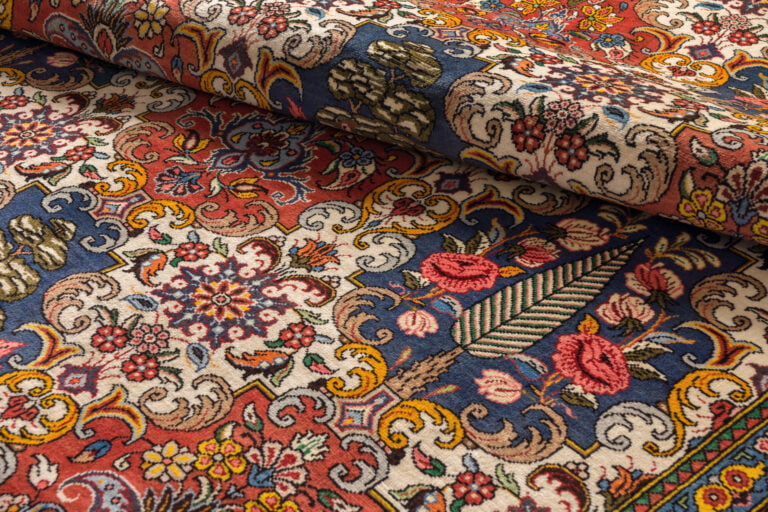Are you trying to decipher the enigmatic symbols that give Oriental rugs their mystique? Understanding the symbols identifying Oriental rug patterns is essential for collectors and admirers alike. This guide will provide you with the insights to recognize and interpret the heritage woven into each rug, from the cultural narratives depicted in Persian medallions to the geometric motifs of Turkish craftsmanship and the powerful symbols of Caucasian tribal art.
Jump to section
Key Takeaways
Oriental rugs contain symbols that convey cultural tales and values, and their patterns can be associated with specific origins like Persian, Turkish, and Caucasian styles, each with unique motifs and symbolic meanings.
Details such as color symbolism, border patterns, and the presence of a central medallion are key elements in an Oriental rug’s design, adding to the story and conveying distinct narratives integral to the rug’s artistry.
Collecting Oriental rugs involves understanding their authenticity, proper care, and the various factors contributing to their value, such as provenance, uniqueness, craftsmanship, and materials, to make informed investment decisions.
Unraveling the Mystery of Oriental Rug Symbols
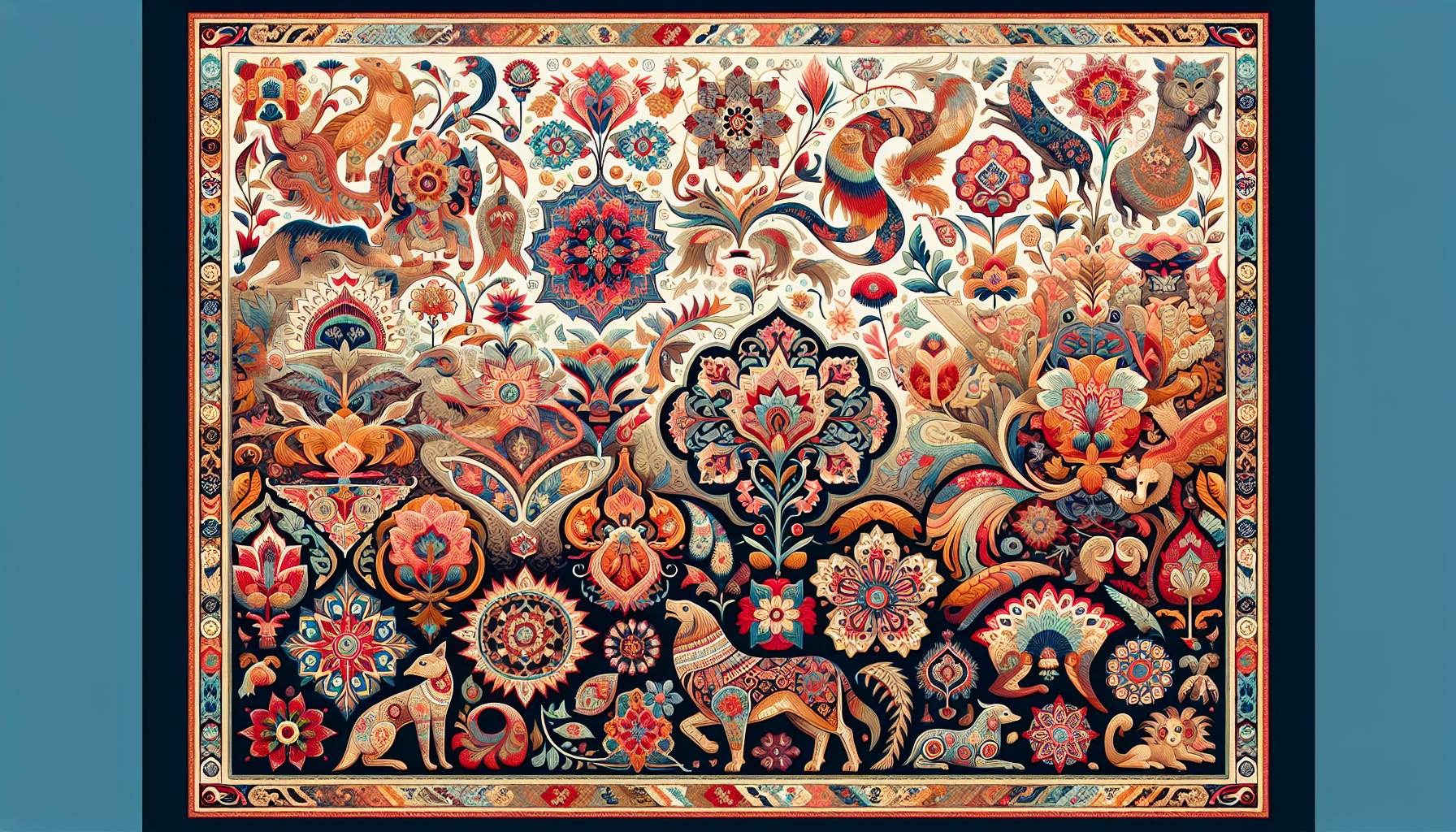
The magic of Oriental rugs lies in their ability to communicate tales of the past through symbols and patterns. Each stitch, each knot, is a word in a language that transcends time and space, revealing the creator’s dreams and aspirations. The central medallion, a design element often found in these rugs, symbolizes important cultural aspects like the divine realm, emphasizing the storytelling aspect of each rug.
Every symbol on a rug serves as a narrative element, crafted from the artisan’s memory, which contributes to the rug’s uniqueness. As we understand more about the complexities of carpet making and the stories behind the symbols, our admiration for this art form grows.
We will now explore the intricate language of symbols commonly found in Persian, Turkish, and Caucasian rugs.
Persian Rug Symbolism
Persian rugs, also known as Persian carpets, are renowned for:
Their rich history
The intricate floral and curvilinear patterns woven into their design
The floral designs, dating back to the 16th century, influenced by the Shabasi design and other prevalent floral motifs of the time
The curvilinear patterns that establish a sense of harmony among the various design elements, creating a beautiful visual symphony.
A unique approach to floral patterns can be observed in some Persian rugs, where the focus is primarily on the arrangement of flowers, without the inclusion of stems or leaves. This unique design element further contributes to the rich tapestry of stories woven into each handmade Persian rug.
Turkish Rug Symbolism
Turkish rugs are characterized by their clean geometric shapes and a palette of saturated colors, a reflection of historical opulence from the Ottoman Empire. One of the quintessential geometric symbols found in these rugs is the Göl design. This octagonal pattern, resembling an elephant’s foot, repeats throughout the textile, adding depth and visual interest.
Another common symbol found in Turkish rugs is the Elibelinde motif. This Anatolian motif represents motherhood and fertility, depicted as a stylized female figure with hands on her hips. The geometric shapes and vibrant colors in Turkish rugs symbolize key aspects of life, embodying themes such as family connectivity, the endurance of nature, and the continuity of life through designs like the Elibelinde and Göl.
Caucasian Rug Symbolism
Caucasian rugs are notable for their bold geometric patterns, symbolic of the diverse tribal origins of the weavers. Among these patterns, the dragon symbol is often found, representing strength and power, echoing the importance of these traits in the weaver’s tribes.
The functional needs tied to a nomadic lifestyle are reflected in the construction of flat weave rugs, using durable wool and simple, portable looms. This nomadic influence is also evident in the design, with a sense of spontaneity in the patterns that can be attributed to the improvisational lifestyle of the weavers.
Motifs such as the ‘Eagle’ and the ‘Star’, carrying symbolism related to protection and spirituality, are also found in Caucasian rugs. These motifs, steeped in symbolism, add a layer of cultural significance to these hand-knotted rugs.
Decoding Common Oriental Rug Motifs
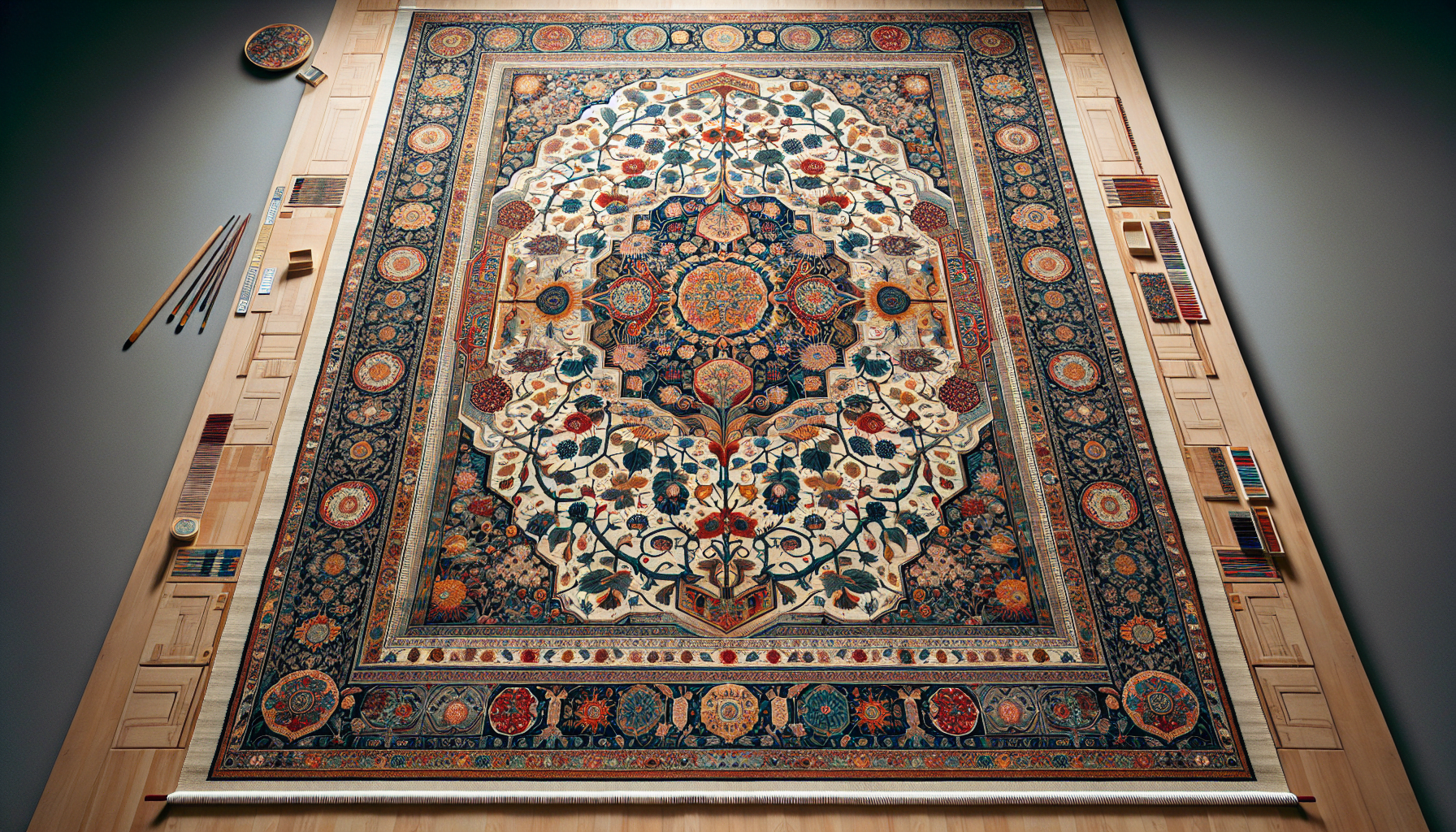
Continuing our exploration of the world of Oriental rugs, we turn our attention to the variety of motifs that frequently embellish these textiles. One such frequently encountered motif is the Herati pattern. Consisting of a diamond framework and a single floral head surrounded by acanthus leaves, this motif is referred to as Mahi, which means ‘fish’ in Persian.
Multiple border bands featuring repeated motifs such as flowers, rosettes, and geometric shapes often adorn Oriental rugs, each contributing to the rug’s complexity and narrative. These borders, while decorative, are also seen as protective elements that flank the main border of Oriental rugs. Now, let’s examine these motifs further, starting with floral motifs, and then moving on to geometric and animal motifs.
Floral Motifs
Floral motifs, considered timeless and traditionally significant, have sustained their popularity over the years. Different plants and floral elements in rugs symbolize various life concepts, with blossoms representing youth and spring, and cypress trees symbolizing immortality.
The Herati pattern, originating from Herat, features a diamond with a floral head, embodying the concept of fish swimming in the full moon’s reflection. Persian vase patterns, often depicting a Grecian urn within the rug design, signify a legacy being passed through generations.
Other motifs like the lily and iris are synonymous with purity, spirituality, and religious liberty, while the lotus flower denotes rebirth and immortality.
Geometric Motifs
Geometric motifs in oriental rugs are associated with various styles and types, such as:
Heriz
Hamadan
Sarouk
Bokhara
Kazak
Khal Mohammadi rugs
These motifs are characterized by straight and angular lines such as rectangles, angles, and triangles.
Circles are rarely utilized in geometric patterns on rugs because they would appear angular instead of round due to the knotting technique. Rugs with geometric patterns often have a lower knotting density and are typically found in village and nomadic creations, including:
Gabbeh
Shiraz
Hamadan rugs
Kilims
Animal Motifs
Animal motifs in rugs can signify a variety of concepts, such as birds for faith and fertility, cows for earth and mankind, and camels for wealth, prosperity, and fertility. In Persian rugs, the eagle symbolizes spiritual high-mindedness and good fortune, while the leopard represents bravery.
Different animal motifs carry distinct symbolic meanings:
Dogs represent protection and defense
Snakes are associated with wisdom and happiness
Parrots symbolize protection
Antelopes are associated with restfulness
These motifs, rich with symbolism, add depth and narrative to the intricate designs of Oriental rugs.
The Art of Reading Oriental Rug Patterns
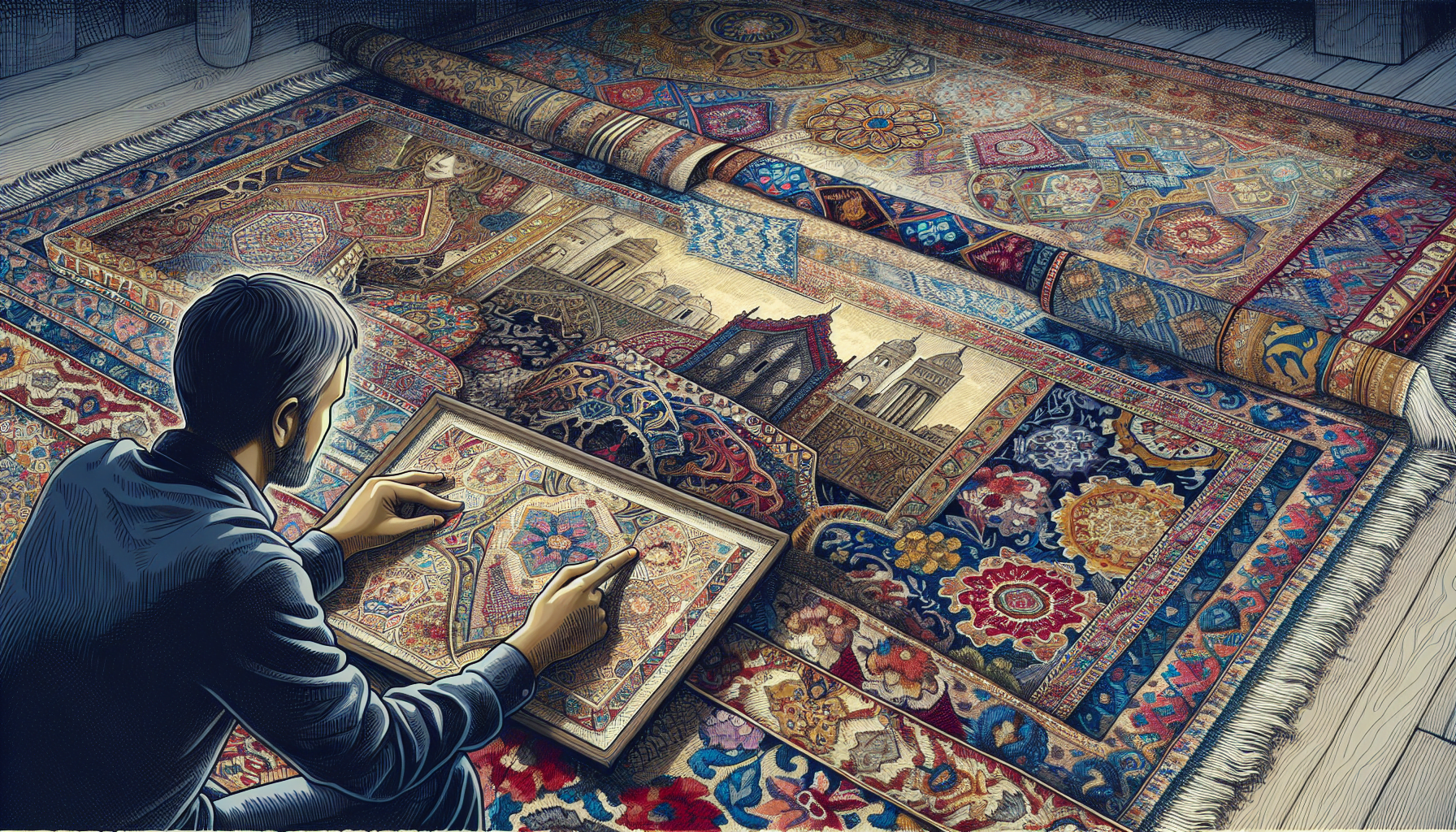
In order to decipher the mysteries of Oriental rug patterns, we must learn how to interpret the colors, border patterns, and central medallions in these rugs. Colors in Oriental rugs, for instance, have specific meanings and convey narratives integral to the rug’s artistry.
In the subsequent sections, we will explore more about the symbolism of colors, the role of border patterns, and the importance of the central medallion.
Color Symbolism
Each color in an Oriental rug carries specific symbolic meanings, which add depth to their aesthetic appeal. Red, for instance, can symbolize happiness, joy, luck, courage, wealth, and vibrant energy. Green, being a sacred color associated with the Prophet Mohammed, represents hope, renewal, life, paradise, and spring.
White conveys a sense of peace, purity, and cleanliness, while brown signifies fertility and homage to the earth and soil. Black is frequently used for outlines or borders and represents forcefulness, restfulness, and mystery. Orange, on the other hand, stands for devotion, faith, and humility. Colors in Oriental rugs, such as water, gardens, and paradise birds, also carry thematic symbolism crucial to survival, representing Paradise.
Understanding the color symbolism in Oriental rugs is essential for appreciating the emotional and cultural narratives woven into these works of art.
Border Patterns
Oriental rugs typically feature two types of borders: the main border and the guard border. The main border is a dominant feature that frames the central design of an Oriental rug. The guard border serves as a complementary element to the main border, adding an extra layer of patterning and intricacy.
Together, the main and guard borders add depth and complexity to the overall composition of an Oriental rug, enhancing its aesthetic and symbolic value. The border patterns serve not only as decorative elements but also as protective elements, making them an integral part of the rug’s design and symbolism.
Central Medallion
The central medallion is a dominant feature in Oriental rugs, occupying a central position and often distinguished by its large size. Central medallions can vary in their stylistic execution, number across the field, and the extent to which they are embellished or superimposed onto backgrounds filled with other motifs.
In medallion floral rugs, the presence of a large central medallion limits space for surrounding motifs, which leads to the use of smaller flower designs compared to those in allover floral patterns. A central medallion may incorporate a four-motif design believed to signify a symbolic ‘Door of Sun’, adding a protective element to the design of the rug.
Identifying Rug Origins Through Symbolism
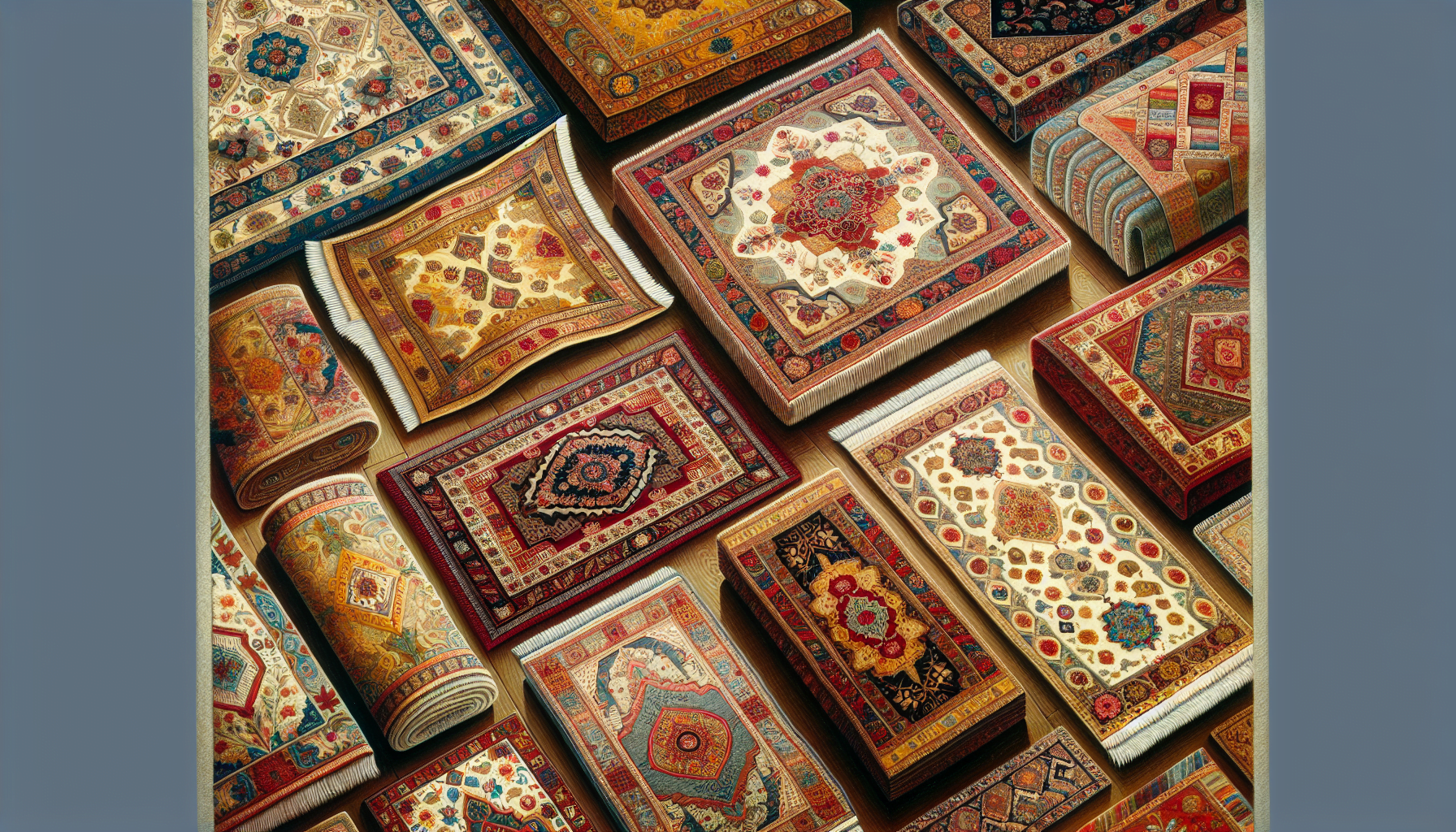
Identifying the origin of an Oriental rug can be as intriguing as deciphering its symbols and motifs. Each rug carries the signature of its origin, reflected in its unique design, colors, and craftsmanship. Whether it’s a Persian rug with its intricate floral motifs, a Turkish rug with bold geometric patterns, or a Caucasian rug with tribal symbols, each rug tells a story of its roots.
In the subsequent sections, we will explore more about how to identify Persian, Turkish, and Caucasian rugs. By understanding the unique symbols and motifs associated with each origin, you can appreciate the rich heritage these rugs carry and make informed decisions when adding to your collection.
Persian Rugs
Persian rugs are known for a variety of design configurations, including:
All-over patterns
Central medallions
One-sided designs
Compartmentalized designs
The Shah Abbasi design, named after and originating from Isfahan, features large palmette-like flowers with slender stems, branches, and smaller floral motifs intertwined, reflecting the intricacy of Persian rug patterns.
The richness of design and the depth of symbolism in oriental and Persian rugs are a testament to the skill and creativity of the artisans who weave these exquisite pieces. Every hand-knotted Persian rug carries the signature of its creator, adding to its unique appeal and value.
Turkish Rugs
Turkish rugs, such as the Kazak and Oushak types, often feature striking geometric patterns, including geometric lines and central medallions. Traditional Turkish rugs like Kazak carpets are known for their vivid blue and red colors, achieved through the use of high-quality natural dyes.
Soumak carpets, a type of Turkish rug, are renowned for their thick, durable, strong flat weave and vibrant colors, making them both functional and visually appealing. The distinct design elements and vibrant colors of Turkish rugs make them easy to identify and a popular choice among collectors.
Caucasian Rugs
Caucasian Kilim rugs are traditionally made using goat’s hair, a material known for its strength and stiffness. This choice of material reflects the practical needs of the Yürüks, the nomadic tribes, as it provided them with a durable and waterproof covering for their tents.
Besides the use of goat’s hair, Caucasian rugs are known for their bold geometric patterns, reflecting their tribal origins. The distinct design elements and the use of specific materials help in identifying Caucasian rugs and appreciating their unique charm.
Tips for Collecting and Caring for Oriental Rugs
As we near the end of our exploration, understanding how to evaluate the authenticity of Oriental rugs, how to care for them, and how to invest in valuable pieces becomes crucial. Each hand-knotted Oriental rug is unique due to the individual interpretation or taste each knotter brings into a carpet. Understanding this uniqueness is crucial when evaluating the authenticity of a rug and determining its value.
In the subsequent sections, we will share tips on evaluating authenticity, maintaining your rugs, and investing in Oriental rugs. These insights will help ensure that your collection remains vibrant and valuable for generations to come.
Evaluating Authenticity
Authentic Oriental rugs, often considered as handmade rug, are traditionally made from natural materials like:
sheep’s wool
cotton
camel hair
silk
These beautiful handmade rugs, including silk rugs, are not only a testament to skilled craftsmanship but also a perfect addition to any home decor, setting most oriental rugs apart from machine made rug options.
The quality and authenticity of a Persian rug can often be determined by its knot density, with higher densities indicating greater detail and craftsmanship.
Characteristics such as irregularities on the reverse side, integrated rather than sewn-on fringes, and the uniqueness of each hand-knotted rug are key indicators of authenticity. Recognizing authentic materials, artisanal knotting techniques, and crafting details like knot density helps collectors to evaluate the authenticity of an Oriental rug.
Proper Care and Maintenance
Maintaining the beauty and value of Oriental rugs requires specific care and attention. Thinner pile in Persian rugs, considered higher quality, requires specific maintenance approaches to preserve the fine craftsmanship. Professional handwashing by rug cleaning experts is necessary to prevent dye bleeding and maintain the rug’s intricate patterns and colors.
The colors in high-quality Oriental carpets, including antique carpets, often come from natural sources like plants and minerals, which may require special care to prevent fading over time.
Investing in Oriental Rugs
Investing in Oriental rugs requires a thorough understanding of the factors that contribute to a rug’s value. Factors such as:
Provenance
Uniqueness of design
Quality of craftsmanship
Materials used
play a critical role. Rugs in excellent condition and with minimal restoration are considered more valuable and sought after by collectors.
Moreover, age and rarity add to an Oriental rug’s appeal and can significantly increase its collectability, with antique rugs often drawing the attention of serious collectors. Armed with this knowledge, collectors and investors can make informed decisions and appreciate the true value of these works of art.
Summary
We’ve journeyed through the intricate world of Oriental rugs, discovering symbols that tell tales of ancient cultures and traditions. From the floral motifs of Persian rugs to the bold geometric patterns of Turkish and Caucasian rugs, we’ve learned how to decipher the narratives woven into these textiles. We’ve also explored how to evaluate the authenticity of these rugs, care for them properly, and invest in valuable pieces. As we continue to appreciate and collect these works of art, let’s carry forward the stories they tell, ensuring that these narratives continue to inspire future generations.
Frequently Asked Questions
What are the common symbols in Oriental rugs?
Oriental rugs often feature symbols such as floral motifs symbolizing life concepts, birds denoting faith and fertility, and geometric patterns embodying themes like family connectivity and the endurance of nature. These symbols convey stories and cultural significance.
How can I identify the origin of an Oriental rug?
You can identify the origin of an Oriental rug by examining its design, colors, and craftsmanship. Persian rugs have intricate floral motifs, Turkish rugs feature bold geometric patterns, and Caucasian rugs reflect tribal origins with distinct symbols.
How can I tell if an Oriental rug is authentic?
You can tell if an Oriental rug is authentic by examining its characteristics such as irregularities on the reverse side, integrated fringes, and the uniqueness of each rug. These are key indicators of authenticity.
How should I care for my Oriental rug?
To care for your Oriental rug, it’s crucial to seek professional handwashing by experts to prevent dye bleeding and preserve its intricate patterns and colors. This will help maintain its beauty and value in the long run.
What factors determine the value of an Oriental rug?
The value of an Oriental rug is determined by its provenance, uniqueness of design, quality of craftsmanship, materials used, condition, restoration, age, and rarity. These factors collectively influence the rug’s overall worth.
